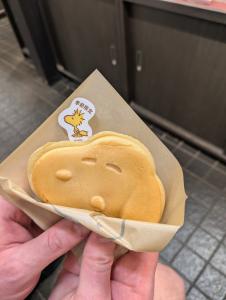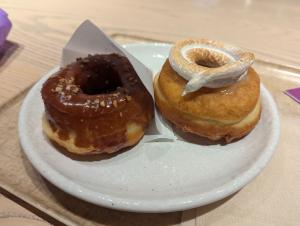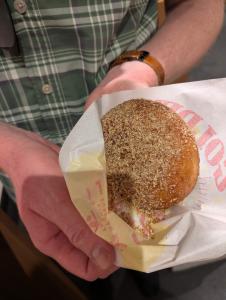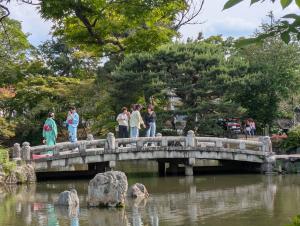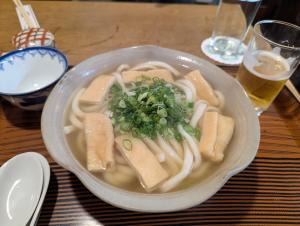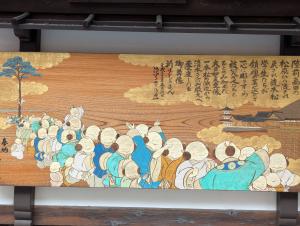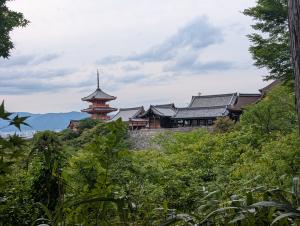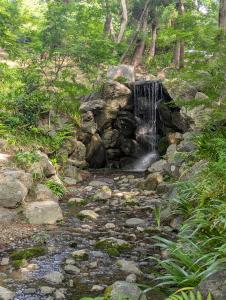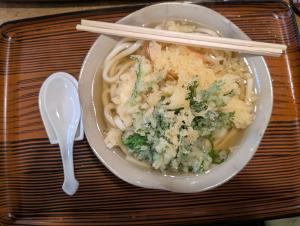Day 10 - Memoirs of Kyoto
Nishiki Market - Gion District - Kiyomizu-dera
Today was packed. So we chose to have breakfast at Nishiki Market. The pedestrian-only, covered Nishiki Market is right in the centre of town, one block north of Shijō-dōri, running from Teramachi shōtengai (market streets) to Takakura-dōri (ending almost behind Daimaru department store). It’s said that there were shops here as early as the 14th century, and it’s known for sure that the street was a wholesale fish market in the Edo period (1603–1868). After the end of Edo, as Japan entered the modern era, the market became a retail market, which it remains today.
The emphasis is on locally produced Japanese food items such as tsukemono (Japanese pickles), tea, beans, rice, seaweed and fish. We sampled tempura eel, sake, strawberry cream taiyaki in the shape of Snoopy's head, a curry bun, and takoyaki. In recent years the market has been evolving from a strictly local food market into a tourist attraction, and you’ll now find several shops selling Kyoto-style souvenirs mixed in among the food stalls. We were able to buy several souvenirs for ourselves and others. Lisa's still searching for the ultimate handbag, but thinks she might be closing in on a winner. In addition to our market shopping, we also visited the Nintendo store on the 7th floor of Daimaru department store (ironically, from Lisa's perspective, the 7th floor of Daimau is also hosting an English festival complete with afternoon tea service).
Officially, for lunch, we had conveyor belt sushi at an inexpensive place just outside the market. It was decent fish, but the price point was excellent and there were seats available. We took a spin through the Yasaka Shrine and nearby Maruyama gardens, making multiple donations and offerings along the way. Here, came in contact with one of our biggest conundrums on this trip, young women renting and wearing, but most importantly, photographing themselves in kimonos. I suppose to our sensibilities this is cultural appropriation even though the Japanese don't see it as such, they view it as sharing their culture. Nevertheless, it's incredibly distracting to be trying to pray at a temple, when all of the kimono-clad instagrammers are clamoring for the best picture of themselves looking sweet and innocent in front of anything Japanese.
The same was true for the Gion district. This area of Kyoto is well known for the geisha moving between their lodgings and their place of business. We're lucky that the street is open since in recent years tourists have taken to jumping in front of Geishas demanding photographs and conversation. That's quite all right if you've booked an evening with them, but it's not appropriate while they're walking to their place of work. To solve the problem, the Kyoto city government had closed off the street to tourists for a while. While it's open now, we didn't see any real Geishas (just tourists dressed as them), but we did see the president of a large corporation leaving his appointment.
From Gion we walked East and upward to Kiyomizu-dera. Kiyomizu-dera is one of the city’s most popular temples. Built around a holy spring (kiyomizu means ‘pure water’), the temple has attracted pilgrims since the 8th century AD. The complex includes a Shintō shrine associated with matters of the heart – buy a prayer plaque here to assure success in romance. More importantly, the iconic image of the main temple has been Jon's Windows background for 13 years. To get to Kiyomizu-dera, though, you have to walk through narrow streets of Ninenzaka, preserved to look as they did in Edo times, crammed with tourists and shops on either side selling everything from chopsticks to matcha green tea everything to gemstones. We finally made it to the temple 15 minutes before closing. Jon was able to snap a few shots, Lisa made a temple offering, and we saw most of the grounds before they closed.
Perhaps the highlight of our night and an incident that made up for all of the annoying tourists (of which, we recognize, we are two), was dinner. We chose an udon restaurant within walking distance according to Google maps. When we walked in, we were greeted by the owner, a sweet older Japanese lady who told us that there was no English menu and asked if that was okay in her very limited English. We confirmed and used Google translate to read the menu printed on the wall. We found what we wanted, which was tempura udon and kitsune udon (a fried and seasoned tofu topping), and placed the order. Jon got to practice his Japanese skills when the one other guest in the restaurant turned to us and asked how long we were going to be in Kyoto and where we were from in her also limited English. In what we couldn't express in Japanese, Jon used Translate in conversation mode. She was from Hiroshima and told us she wished we were going to visit there longer. The udon was delicious and exactly what we needed for a long day of sightseeing. The owner could not have been any sweeter. We expressed that the food was very delicious and carried out a bit of a conversation with the owner and other guest before heading back to our hotel.
We’re doing the first of two days of laundry this evening. It will take 24 hours to dry which will give us enough time to do a second load tomorrow (who knew laundry would make for interesting reading).
Points earned today!
| L | Activity | J |
|---|---|---|
| 6 | Adventurous Eater | 6 |
| 3 | Foodie (Unique foods) | 3 |
| Historical Panorama | 1 | |
| 7 | Souvenir: Food | |
| 1 | Souvenir: Small Items | |
| 2 | Gift Giver Award | |
| 1 | Water Panorama | |
| 9 | Souvenir Set Complete | 9 |
| Souvinier: Clothing | 7 | |
| 4 | Donations | 2 |
